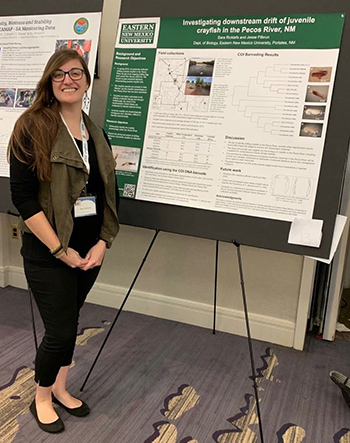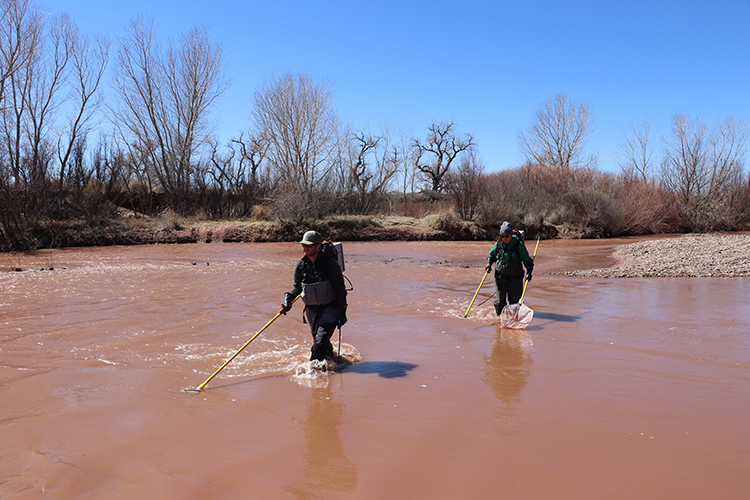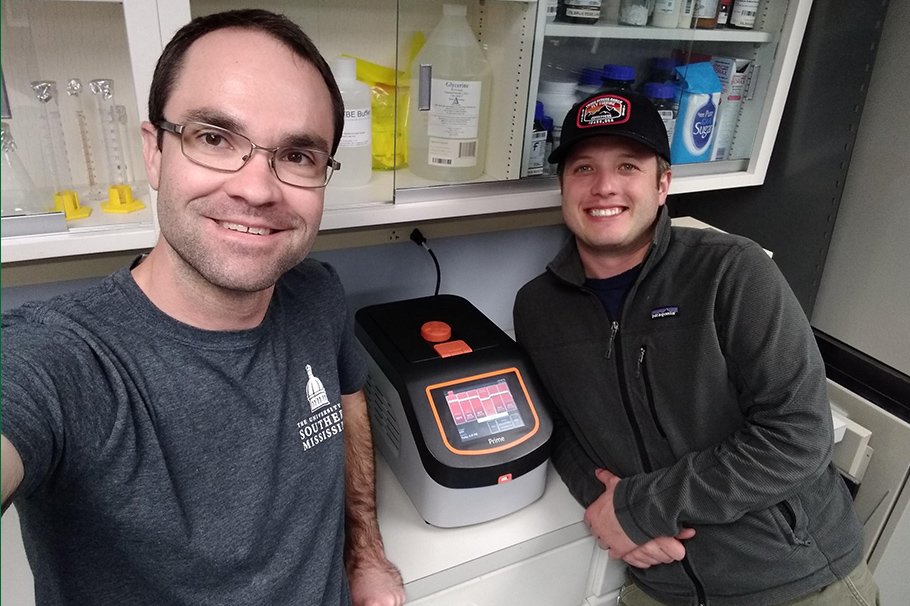It has been a busy semester for Dr. Jesse Filbrun, assistant professor of biology at Eastern New Mexico University, and his students Sara Ricklefs and Rick Raymondi. They've conducted research, attended an American Fisheries Society meeting to give presentations and even received a research grant.
They also took the time to chat with the ENMU News about their research, presentations and more:
Dr. Filbrun
Tell us about the conference.
My graduate students (Sara Ricklefs and Rick Raymondi, MS Biology candidates) and I recently attended the Annual Meeting of the Southern Division of the American Fisheries Society (SDAFS) in Little Rock, Arkansas, which was held February 20-23. We chose to attend this conference because it was a large regional conference attended by over 500 fisheries professionals working in academia, state and federal agencies, private industry and non-profit organizations. Attending this meeting provided an excellent opportunity for us to exchange research findings, network with colleagues and develop new collaborations. We contributed abstracts to present our recent research findings. Our abstracts were reviewed and accepted by the organizing committee.
How did you and your students prepare for the conference?
Sara, Rick and I independently designed our presentations for the conference. Then, we passed drafts of them among the three of us for several rounds of editing to improve scientific and aesthetic content. We practiced the final drafts of our presentations as a group.
Describe your conference experience.
The SDAFS Meeting in Little Rock was excellent. It was well-attended and well-organized. I presented a poster of my Pecos River work and an oral presentation of my most recent catfish aquaculture findings. I was able to reconnect with existing colleagues and meet new collaborators working on similar issues across the country. Networking is my favorite part of conferences. I also served as a judge for the Student Best Oral Presentations symposium and a mentor for the student-mentor lunch. I was impressed by the quality of the student presentations, and I enjoyed meeting the students, discussing graduate school experiences and career goals and providing my advice for future success.
What did it mean to you to have Sara receive an honorable mention?
Any time a student is recognized at a regional conference for excellence in research, that is a great thing for our lab and for ENMU. I am proud of Sara's and Rick's accomplishments.
Tell us about your research.
I am generally interested in understanding the role of human disturbance on the early life stages of fishes. My current research program has two active components. First, my graduate students and I are quantifying spawning activities of fishes in the Pecos River near Fort Sumner relative to environmental conditions. I initiated a long-term survey of drifting fish eggs and larvae in August 2018. To date, we have collected over 3,600 larvae and hundreds of eggs. We are particularly interested in understanding how reservoir water releases impact spawning efforts by native and nonnative fishes. Second, I am working to improve aquaculture methods for food production of channel catfish and F1 hybrid (channel × blue) catfish. I am finishing up a study of the effects of feed provision on foraging activities and growth of these catfishes during early life.
How were you selected for the faculty research grant program award? What are your plans for the project?
The New Mexico Water Resources Research Institute (NM WRRI) supports research concerning water resource-related problems in part through their Faculty Water Research Grant Program. Funds for this program are provided through the USGS as authorized by Section 104B of the Water Resources Research Act of 1984. I submitted my proposal, Investigating the effects of reservoir water releases on spawning activities of fishes in the Pecos River, in December 2019 and was awarded the grant in February 2020.
Currently, there is limited information regarding the timing of reproductive events by native and nonnative fishes in the Pecos River relative to environmental conditions. Thus, water managers are uninformed regarding potential impacts of the timing and magnitude of reservoir water releases on fish assemblages. This study will fill critical knowledge gaps by quantifying adult spawning movements, drifting egg and larval densities and juvenile survival relative to environmental variation and specifically reservoir water releases.
Ultimately, this information should be considered by water managers to select dates and magnitudes of water releases to inflict minimal impacts on reproductive effort of native fishes. Field work for this project is scheduled for April through September 2020, the months when fishes actively spawn in the river.
ENMU Students Sara Ricklefs and Rick Raymondi

Tell me about your research.
Sara: My thesis consists of two projects. Each uses molecular tools to analyze early life history traits of aquatic organisms in disturbed ecosystems. My first project is based in the Gulf of Mexico. I identified environmental conditions in which three economically important fish species (red drum, red snapper and vermilion snapper) eggs were present. The environmental conditions included salinity, temperature, depth, fluorescence (a proxy for primary productivity), oil platform density and ENSO index values.
My second project is located on the Pecos River in New Mexico. As part of our lab's larger drift survey, last spring we collected approximately 100 juvenile crayfish drifting downstream. We have not found that drift (as a behavior or dispersal mechanism) is represented in crayfish literature. We cannot identify them to species visually because they are very small, so we are using molecular identification tools. This spring, we will survey the adults at each study site and continue to target juveniles with drift nets to further investigate the crayfish assemblage and downstream drift.
Rick: I am proposing research to study the effects of artificially high discharge emitted from reservoirs on native fishes of the Pecos River. The minnows that we are interested in are called pelagic spawners, which means their eggs are released and fertilized in the water column and float downstream in order to hatch into the larval stage. Dams along the Pecos River interrupt the natural flow by fragmenting the system and releasing water only when necessary, so we are curious about the effects this may have on the early life stages of pelagic-spawning minnows.
To address this knowledge gap, we will use a large stream tank that is located near the Science Building on the ENMU campus. We can mimic different levels of flow found in the Pecos River by using a pump system on the tank to test if sustained high discharge is detrimental to larval fish.
How did you prepare to present at the conference?
Sara: I created a poster that encompassed background information, research objectives, lab/field methods and preliminary results from my crayfish project. It was edited and reviewed by my advisor, Dr. Filbrun, and my lab mate, Rick Raymondi. We all practiced as a group prior to leaving for the conference. We focused on presenting big picture takeaways and management-level implications. Our posters were printed on campus at the Golden Student Success Center.
Rick: ENMU offers several courses to graduate students to help prepare them for the professional world. Enrollment in these courses helped build my confidence and provided me with the tools necessary to be able to tactfully explain the technical aspects of my research to a general audience. The education I have been receiving, coupled with guidance from my advisors and lots of practice, helped me prepare for the American Fisheries Society conference.
Describe your conference experience.
Sara: I enjoyed attending the conference in Little Rock. It was the first opportunity I have had to attend a fisheries meeting. I was provided a mentor and had the opportunity to get one-on-one research and career advice over lunch. I was also assigned a peer, which allowed me to make a connection with another student who had never attended an SDAFS meeting.
I attended workshops that focused on the use of trail cameras and molecular tools in research. The range of fisheries research presented was impressive and sparked ideas for future questions I would like to pursue. The socials each evening provided a great place to network and speak with other graduate students.
Rick: The SDAFS conference was my first exposure to a large regional gathering of fisheries experts and leaders. It was intimidating at first, but the atmosphere was extremely laid back, and attendees were genuinely interested in what their peers were working on in the fisheries field. Overall, I had a great experience and was very surprised when I ran into coworkers from previous fisheries work I was involved in who traveled 1,700 miles to attend the conference!
Sara, what did it mean to you to receive an honorable mention?
Sara: I was really excited that I received an honorable mention for my poster, especially since it was my first time presenting at a fisheries meeting. It was an honor to have our team's hard work recognized. Overall, it was a great opportunity for me to get tips and advice from other researchers and fisheries managers.
What was your favorite part of the conference? What did you learn from the conference?
Sara: My favorite part of the conference was attending the Women's Leadership Group session. It was wonderful to connect with other female graduate students and fisheries industry leaders to discuss issues and opportunities in a traditionally male-dominated field. I learned that the fisheries field is filled with researchers and managers who focus on an extremely wide range of topics (from water quality to species conservation to human interactions to ecosystem-level restoration projects and so much more). The Southern Division is particularly interesting since it includes both marine and freshwater systems.
Rick: The best experience of the conference was presenting my research proposal. Being able to field questions and receive feedback provided me with valuable insight on my research. It is always a good idea to have others look over your work as they can give you a different perspective or share advice to further your own knowledge. I definitely walked away feeling more confident with my research proposal and the validity of my research question.
Rick and Sara sampling fishes in the Pecos River



